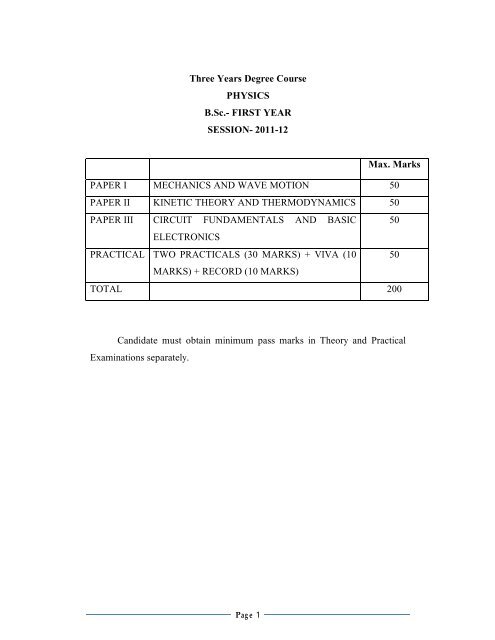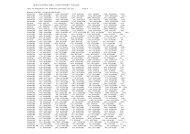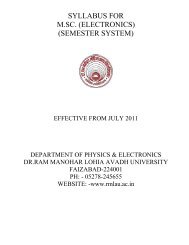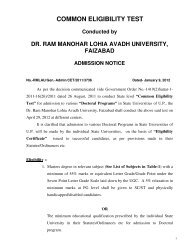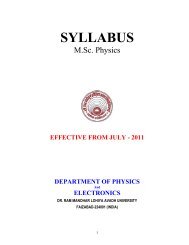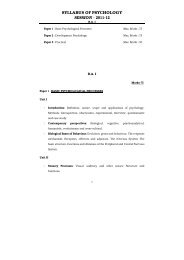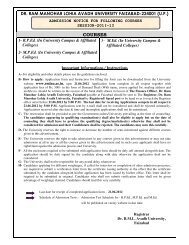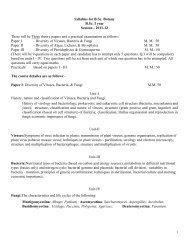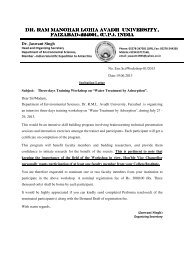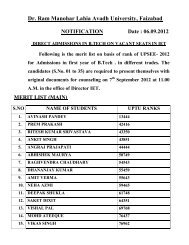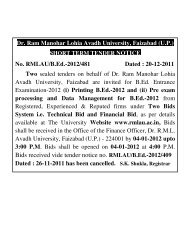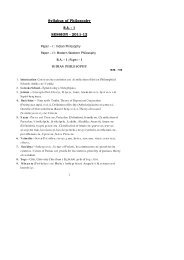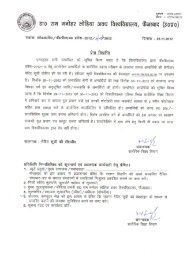Three Years Degree Course PHYSICS B.Sc.- FIRST YEAR ...
Three Years Degree Course PHYSICS B.Sc.- FIRST YEAR ...
Three Years Degree Course PHYSICS B.Sc.- FIRST YEAR ...
Create successful ePaper yourself
Turn your PDF publications into a flip-book with our unique Google optimized e-Paper software.
PAPER I - MECHANICS AND WAVE MOTIONUNIT-IInertial reference frame, Newton’s laws of motion, Dynamics of particle inrectilinear and circular motion, Conservative and Non -conservative forces,Conservation of energy, liner momentum and angular momentum, Collision inone and two dimensions, cross section.UNIT -IIRotational energy and rotational inertia for simple bodies, the combinedtranslation and rotational and motion of a rigid body on horizontal and inclinedplanes, Simple treatment of the motions of a top. Relations between elasticconstants, bending of Beams and Torsion of Cylinder.UNIT - IIICentral forces, Two particle central force problem, reduced mass, relative andcentre of mass motion, Law of gravitation, Kepler’s laws, motions of planetsand satellites, geo-stationary satellites.UNIT IVSimple harmonic motion, differential equation of S. H. M. and its solution, usesof complex notation, damped and forced vibrations, composition of simpleharmonic motion.Differential equation of wave motion, plane progressive waves in fluid media,reflection of waves, phase change on reflection, superposition, stationarywaves, pressure and energy distribution, phase and group velocity.Text and Reference BooksEM Purcell, Ed: “Berkeley Physics <strong>Course</strong>, Vol. 1, Mechanics” (McGraw-Hill). RP Feymman, RB Lighton and M Sands; “The Feymman Lectures inPhysics”, Vol. 1 (BI Publications, Bombay, Delhi, Calcutta, Madras).J.C. Upadhyay: ‘Mechanics’.Page 2
D.S, Mathur “Mechanics”,P.K. Srivastava: “Mechanics” (New Age International).PAPER II- KINETIC THEORY AND THERMODYNAMICSUNIT-IIdeal Gas: Kinetic model, Deduction of Boyle’s law, interpretation oftemperature, estimation of r.m.s. speeds of molecules. Brownian motion,estimate of the Avogadro number. Equipartition of energy, specific heat ofmonatomic gas, extension to di- and triatomic gases, Behaviour at lowtemperatures. Adiabatic expansion of an ideal gas, applications to atmosphericphysics.Real Gas: Vander Waals gas, equation of state, nature of Van der Waalsforces, comparison with experimental P-V curves. The critical constants, gasand vapour. Joule expansion of ideal gas, and of a Vander Waals gas, Joulecoefficient, estimates of J-T cooling.UNIT -IILiquefaction of gases: Boyle temperature and inversion temperature. Principleof regenerative cooling and of cascade cooling, liquefaction of hydrogen andhelium. Refrigeration cycles, meaning of efficiency.Transport phenomena in gases: Molecular collisions, mean free path andcollision cross sections. Estimates of molecular diameter and mean free path.Transport of mass, momentum and energy and interrelationship, dependence ontemperature and pressure.UNIT - IIIThe laws of thermodynamics: The Zeroth law, various indicator diagrams,work done by and on the system, first law of thermodynamics, internal energyas a state function and other applications. Reversible and irreversible changes,Carnot cycle and its efficiency, Carnot theorem and the second law ofthermodynamics. Different versions of the second law, practical cycles used ininternal combustion engines. Entropy, principle of increase of entropy. ThePage 3
thermodynamic scale of temperature; its identity with the perfect gas scale.Impossibility of attaining the absolute zero;third law of thermodynamics. Thermodynamic relationships: Thermodynamicvariables; extensive and intensive, Maxwell’s general relationships, applicationto Joule-Thomson cooling and adiabatic cooling in a general system, Van derWaals gas, Clausius-Clapeyron heat equation. Thermodynamic potentials andequilibrium of thermodynamical systems, relation with thermodynamicalvariables. Cooling due to adiabatic demagnetization, production andmeasurement of very low temperatures.UNIT -IVBlackbody radiation: Pure temperature dependence, Stefan-Boltzmannlaw, pressure of radiation, spectral distribution of Black body radiation, Wien’sdisplacement law, Rayleigh-Jean’s law, Plank's law the ultraviolet catastrophy.Text and Reference BooksG.G. Agarwal and H.P. Sinha “Thermal Physics”S.K. Agarwal and B.K. Agarwal “Thermal Physics”PAPER III - CIRCUIT FUNDAMENTALS AND BASICELECTRONICSUNIT-IGrowth and decay of currents through inductive resistances, charging anddischargingin R.C. and R.L.C. circuits, Time constant, Measurement of high resistance.A.C. Bridges, Maxwell’s and <strong>Sc</strong>herings Bridges, Wien Bridge.THINLY, NORTON and Superposition theorems and their applications.UNIT -IISemiconductors, intrinsic and extrinsic semiconductors, n-type and p-typesemiconductors, unbiased diode forward bias and reverse bias diodes, diode asPage 4
a rectifier, diode characteristics, zener diode, avalanche and zener breakdown,power supplies, rectifier, bridge rectifier, capacitor input filter, voltageregulation, zener regulator.Bipolar transistors, three doped regions, forward and reverse bias, DC alpha,DC betatransistor curves.UNIT - IIITransistor biasing circuits: base bias, emitter bias and voltage divider bias, DCload line.Basic AC equivalent circuits, low frequency model, small signal amplifiers,common emitter amplifier, common collector amplifiers, and common baseamplifiers, current and voltage gain, R.C. coupled amplifier, gain, frequencyresponse, equivalent circuit at low, medium and high frequencies, feedbackprinciples.UNIT-IVInput and output impedance, transistor as an oscillator, general discussion andtheory of Hartley oscillator only.Elements of transmission and reception, basic principles of amplitudemodulation and demodulation. Principle and design of linear multimeters andtheir application, cathode ray oscillograph and its simple applications.Text and Reference BooksB.G. Streetman; “Solid State Electronic Devices”, IInTdi Edition (Prentice Hallof India, New Delhi, 1986).W.D. Stanley: “Electronic Devices, Circuits and Applications” (Prentice-Hall,New TTC’A 1flOO\ JL4y, JJI. 1OO).J.D. Ryder, “Electronics Fundamentals and Applications”, lI’’ Edition(Prentice-Hall of India, New Delhi, 1986).J Millman and A Grabel, “Microelectronics”, International Edition (McGrawHill Book Company, New York, 1988).Page 5
PRACTICALSEvery institution may add any experiment of the same standard in the subject.Mechanics1. Study of laws of parallel and perpendicular axes for moment of inertia.2. Study of conservation of momentum in two dimensional oscillations.Oscillations1. Study of a compound pendulum.2. Study of damping of a bar pendulum under various mechanics.3. Study of oscillations under a bifilar suspension.4. Potential energy curves of a 1-Dimensional system and oscillations in itfor various amplitudes.5. Study of oscillations of a mass under different combinations of springs.Properties of matter1. Study of bending of a cantilever or a beam.2. Study of torsion of a wire (static and dynamic methods)Kinetic theory of matter1. Study of Brownian motion.2. Study of adiabatic expansion of a gas.3. Study of conversion of mechanical energy into heat.4. Heating efficiency of electrical kettle with varying voltages.Thermodynamics1. Study of temperature dependence of total radiation.2. Study of temperature dependence of spectral density of radiation.3. Resistance thermometry.Page 6
4. Thermo-emf thermometry5. Conduction of heat through poor conductors of different geometries.Circuit fundamentals1. Charging and discharging in R.C. and R.C.L. circuits.2. High resistance by leakage.3. A.C. Bridges.4. Half wave and full wave rectifiers.5. Characteristics of a transistor in CE,CB and CC configurations6. Frequency response of R.C. coupled amplifier.WavesI. Speed of waves on a stretched string.2. Studies on torsional waves in a lumped system.3. Study of interference with two coherent sources of sound.Text and reference booksD.P. Khandelwal, “A laboratory manual for undergraduate classes” (VaniPublishingHouse, New Delhi).S.P. Singh, “Advanced Practical Physics” (Pragati Prakashan, Meerut).Worsnop and Flint- Advanced Practical physics for students.Page 7


